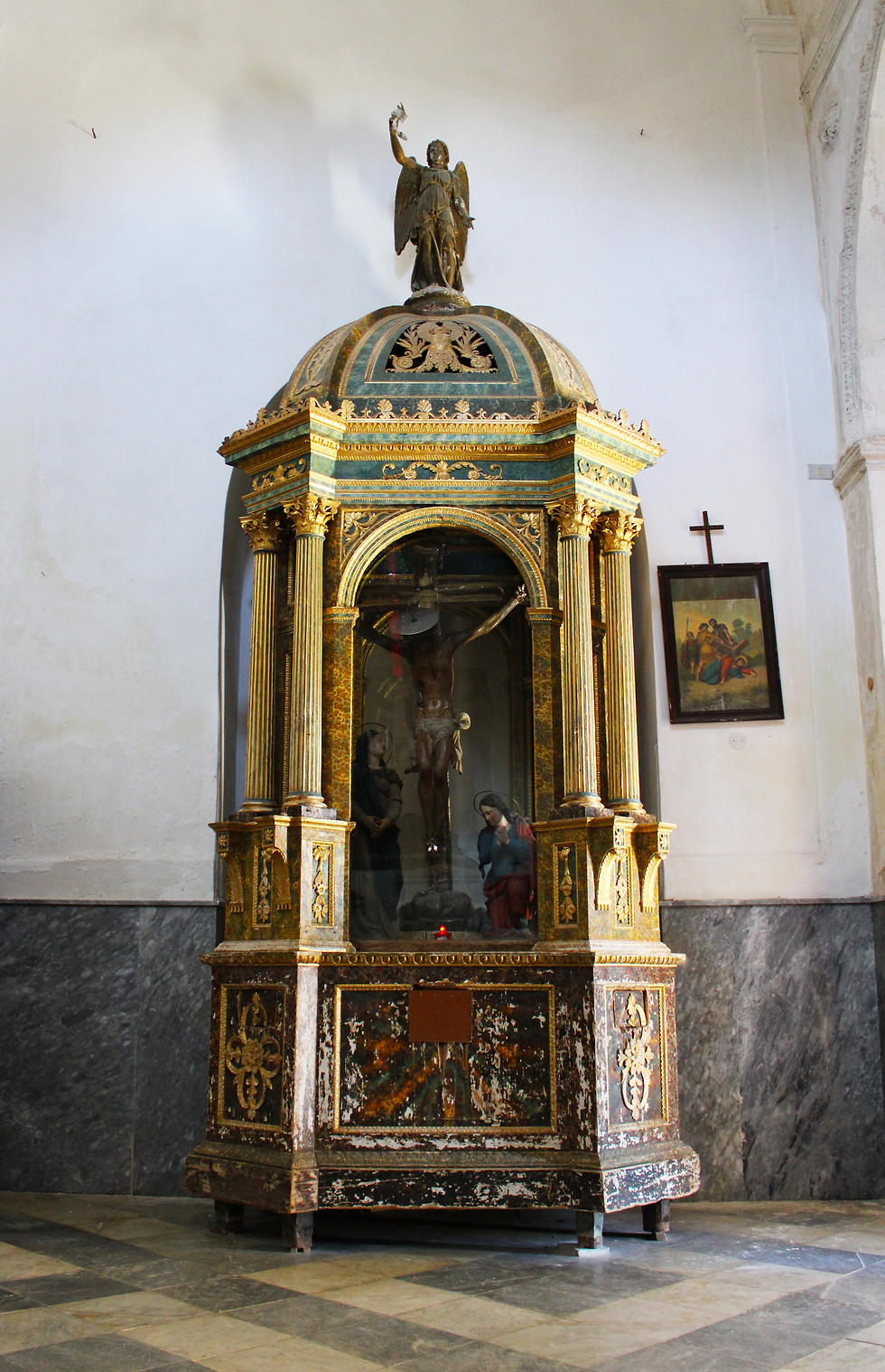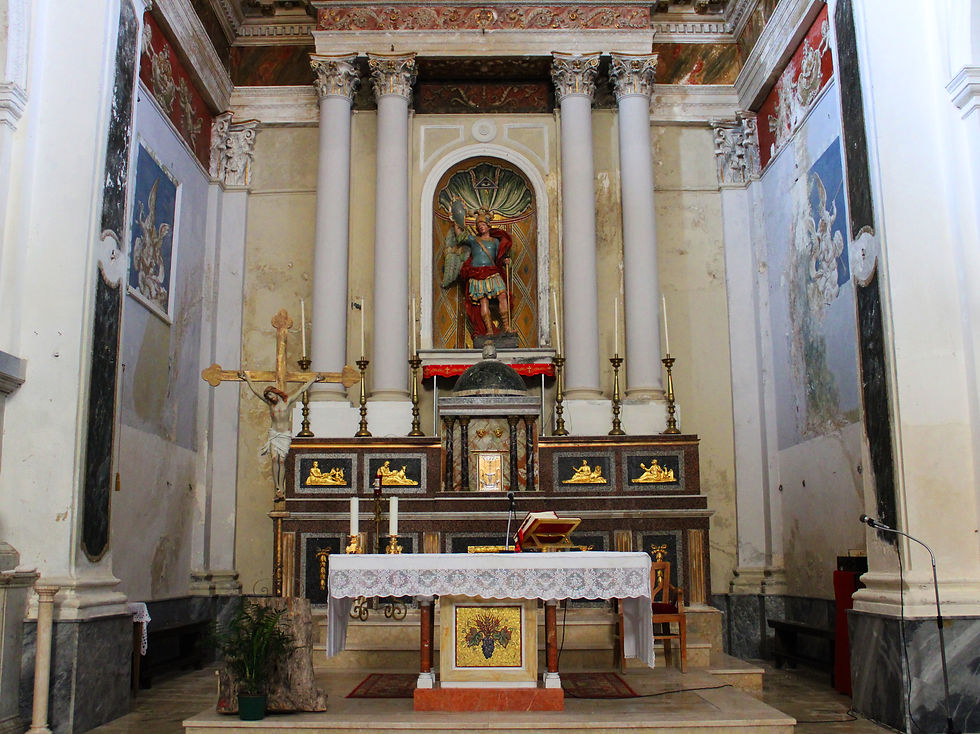A façade with a Sicilian renaissance flavor
The façade is of the Renaissance style, divided into a taller central section with a rose window and a pediment at the top, flanked by two lower lateral sections, all framed by pilasters of the composite order. The entrance portal is adorned with pilasters supporting an arch, paired columns, and an architrave sculpted with motifs typical of the Renaissance culture. This style was introduced to Sicily by the workshop of the famous Gagini family of sculptors, active on the island between the 15th and 16th centuries. The façade is crowned by a broken pediment with a central niche.
The Church of San Michele
We are in the historic heart of Sambuca, in its Arab quarter, situated at the highest point of the town. This area is a maze of perfectly restored alleys that resemble a genuine Arab Kasbah, stretching from Piazza Navarro to Largo San Michele, and then reaching the Belvedere. Here stands the church dedicated to St. Michael the Archangel, traditionally considered the second oldest church in Sambuca, after the Church of St. George.
A worksite in continuous evolution
The church, which today features a Latin cross layout with three naves and quadrangular columns supporting barrel vaults, was likely founded shortly after the expulsion of the Saracens in the first half of the 13th century. However, it was in 1596, during the building's renovation, that the entire façade was completed, financed by Giuseppe Amodei. During this phase, the bell tower with a spiral staircase made of concentric blocks of sandstone was constructed, as well as the church's three portals (one for each nave). The end date of the construction is known from an inscription on the pedestal of the column near the portal, which disappeared in 1932 when the vaults of the central and right naves collapsed, prompting a restoration of the church down to its foundations. Around the 1950s, the central nave's vault, damaged by a fire, was rebuilt thanks to the efforts of two sisters who were teachers: Maria and Beatrice Di Giovanna.
The Church "with Two Facades"
The church has three naves, each corresponding to a frontal entrance on its facade—a feature unique to San Michele and the Church of the Rosary in Sambuca. Originally, the main door was on the opposite side, now the apse, facing the same square where the Church of San Giorgio once stood in the 1400s. In 1596, the building was modified, reversing its orientation, which is why San Michele is known as the church with "two facades." The new entrance was opened on the opposite side, where a bastion once enclosed the Arab-influenced core of the town of Zabut. This reorientation was necessary due to the construction of the Truncali Panitteri Palace in the 1500s and the subsequent expansion of the original urban area. Additionally, it adhered to the Christian tradition of orienting churches towards the East (Versus Solem Orientem), where the sun rises, symbolizing Christ. The significance is evident in the "Benedictus" or Canticle of Zechariah, taken from the Gospel of Luke and recited in the Morning Prayer, which refers to "the dawn from on high breaking upon us, to shine on those who dwell in darkness and the shadow of death, and to guide our feet into the way of peace," alluding to the birth of a Savior (Jesus Christ).


A treasure trove of precious wooden and pictorial works
The interior is adorned with stucco and cornices, especially around the arches of the naves. The presbytery area features frescoes on the barrel vault. The church houses the equestrian wooden statue of Saint George from 1597 (currently under restoration), an impressive piece along with its processional structure (created by Marco and Silvio Lo Cascio from Chiusa Sclafani, originally from the nearby church of the same name, which was demolished in 1960). The statue, made of lime wood, depicts Saint George as a young knight, a warrior in armor, rearing on horseback in the act of slaying the dragon, which holds the queen captive at the base of the "vara" (a processional structure), symbolizing the triumph of good over evil. At the base of the processional structure—made of polychrome and gilded willow and poplar wood—eight panels illustrate scenes from the saint's life. On the back of the "vara," an inscription in Latin records the year of its creation (1597) and the subsequent restoration in 1779. Another highly valuable piece is the wooden Crucifix on a silver-plated cross from the late 1500s, a reliquary containing a fragment of the Holy Cross. Every May 3rd, for the Feast of the Holy Cross dedicated to the Invention of the Cross, it is carried in procession on the 18th-century processional bier. The work is attributed to the Costanza brothers, renowned sculptors, carvers, and engravers from Sambuca, known for their medal-making for the Bourbon dynasty in both Naples and Palermo. The processional bier, in fine Corinthian style, features two exquisitely carved and gilded putti at the base of the twin columns supporting the wooden openwork dome, each holding a rooster and a lantern, symbols associated with the Passion of Christ. The other four putti hold a hammer, a nail, a ladder, and a lance. At the base of the bier, two scenes of the Passion: the flagellation and Christ's fall. For the Feast, after an octave with sermons, vespers, and a procession, the statue was displayed on the main altar in a church dressed festively and illuminated by candles. On the evening of May 3rd, placed in the artistic bier made by the Costanza brothers in 1820, it was then carried in procession through the town's streets by the "nudi" (barefoot) Confraternity of the Holy Cross, dressed in gold and silver garments, preceded by all the confraternities and clergy, and followed by the marching band and the people with lit candles. On the main altar, made of polychrome marble with gold finishes (from 1980, like the wooden pulpit), there is a wooden statue of Saint Michael from the early 1600s. On the sides of the apse walls, two fresco reproductions by Gianbecchina—a 20th-century master from Sambuca—depict two angels with trumpets. The church also houses a painting from the 1700s, likely from the school of Mariano Rossi, an Italian painter described as "anti-Baroque," and a fine baptismal font made of alabaster marble, attributed to marble work from the second half of the 16th century. The font features three masks and a siren in a distinctly Gaginian style on the sides of the base, with three relief putti on the shaft supporting the basin (originally from another font or holy water stoup).



